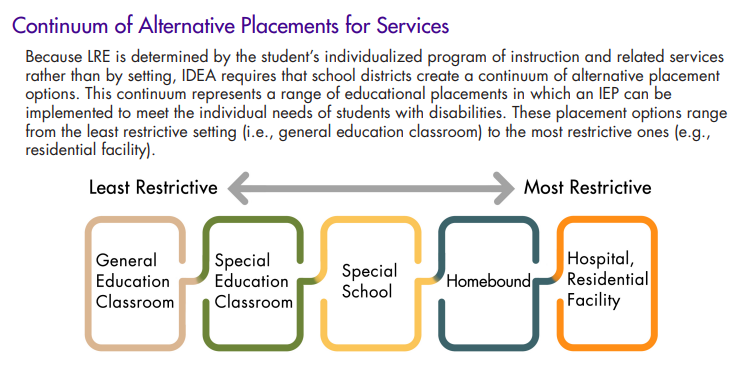The Continuum of Options
One of the primary functions of the SELPA is to facilitate program availability for all students with disabilities within the geographical or legal structure of the SELPA, and regardless of the disability. The regionalized structure of SELPAs gives LEAs a wider variety of options for program design, available personnel, coordinated interagency work, and locally determined professional development. These efficiencies are known as "economies of scale," and are made possible through the cooperation and groupthink of teams of LEA special education leaders, superintendents, and business officials, with SELPA facilitation and consultation on legal and instructional best practices. It is incumbent upon each SELPA to ensure the continuum of programs and services is available to meet the unique needs of each student with a disability, to assist in intra-SELPA and inter-SELPA placements, and to provide technical assistance and administrative support to ensure adherence to the requirements of Federal and State laws. The California Department of Education relies heavily on each SELPA to monitor and hold accountable each of their member districts for compliance with all provisions of state and federal special education law. Click on the insert for a deeper dive into the continuum of options from the IRIS Center at Vanderbilt University.
Click on the insert for a deeper dive into the continuum of options from the IRIS Center at Vanderbilt University.
The SELPA Administrator is responsible for assuring that:
- All individuals with disabilities receive a free appropriate public education in the least restrictive environment.
- All general education resources are considered and, where appropriate, utilized on a local or regional basis to meet the needs of students with disabilities.
- A system exists at the regional level for the identification, assessment, and placement of students with disabilities and the implementation of programs to support them.
- A viable system for public education is functioning in the community, with broad participation and interaction involving parents and other agencies serving children and young adults.
- An annual compliance monitoring system is implemented, that continues to assure non-compliant items that have been identified have and continue to be rectified.
In most SELPAs, program specialists or other specialized staff members also play a critical role in supporting and maintaining the continuum of options within SELPA and LEA special education operations. Their responsibilities include:
- Observing, consulting with, and assisting special education staff
- Assisting LEAs with challenging issues such as persistent non-compliance or finding appropriate placements
- Planning programs, coordinating curricular resources, and evaluating the effectiveness of programs for students with disabilities
- Providing or participating in staff development, program development, and innovation of special methods and approaches
- Leading resolutions or facilitated IEP meetings to build trusting relationships between parents and schools or districts
- Facilitating meetings to assure pupils have full educational opportunities
The SELPA mandate is met through a network of cooperative agreements among LEAs and agencies. SELPAs coordinate this network and provides an objective point of contact and support for the student and/or family seeking information and services. This function is one of the most complex, but truly beneficial, processes of the entire special education delivery system. The complexity of the rules and responsibilities embedded within and surrounding special education has created the need for highly skilled and knowledgeable SELPA administrators who must understand special education laws and how to apply them fairly. They must also know, however, how to organize groups of superintendents, directors, special educators of all job-alike categories, and parent and community leaders around the financial, technical, and program aspects of the work to produce the best outcomes for the students with disabilities in their care.
